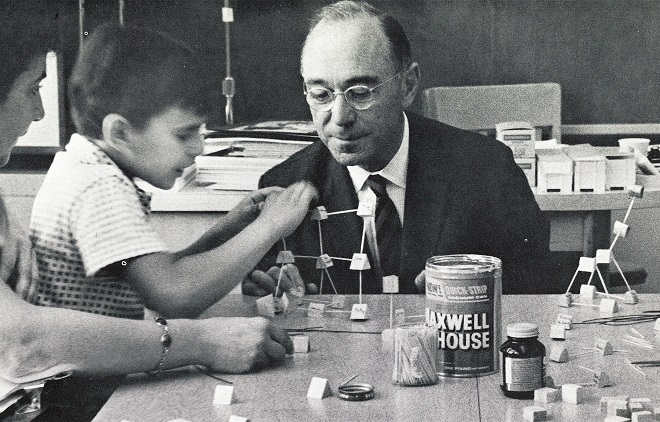Bruner’s Vision
Jerome Bruner's work has influenced countless educators, changing the trajectory of modern teaching practices. Born in 1915 in New York City, he had an impressive academic journey. He served on the faculty at Harvard University, Oxford University, and the New School for Social Research. But while his credentials are undeniably impressive, his ground-breaking insights into education define his legacy. Bruner believed passionately in the active role of the learner, in education not just as a mere transfer of information but a process of discovery. This belief led him to develop the Spiral Curriculum, a revolutionary idea that challenges the linear mode of teaching. At the heart of it are two ideas: Coming back around: Topics aren't just taught once. Instead, the learner comes back to them, time and again, with each iteration delving deeper, broadening horizons and embedding knowledge more securely. Constructivism: Knowledge isn't just absorbed; it's constructed. As students revisit topics, they reconstruct, refine, and integrate their understandings, knitting them into an ever-expanding web of knowledge. The Spiral Curriculum ensures that learning isn't static. Like a helix it's ever-evolving, allowing students to scaffold their understanding of previous knowledge, promoting a deeper and more holistic grasp of subjects.
Core Principles of the Spiral Curriculum
To incorporate the Spiral Curriculum into learning, it’s important to understand the concepts that underpin it.Revisitation
Imagine the joy of meeting an old friend after years, reminiscing over shared memories and then adding new ones. Revisitation in the Spiral Curriculum is similar to this—it has learners returning to familiar topics but with a fresh perspective each time. It prevents concepts from becoming distant memories; instead, they remain active in a learner's brain.Deepening Complexity
With each encounter, the curriculum adds layers—broadening the scope and diving deeper into the subject. It's not about mere repetition but repeated amplification. If the first introduction was just brushing the surface, by the third or fourth one students are exploring the depths and acquainted with the myriad lifeforms underneath.Evolving Understanding
Students are not static vessels; their cognitive structures mature over time. The Spiral Curriculum acknowledges this dynamic nature, ensuring that the curriculum grows as students' abilities to understand nuances grow. It's a harmonious relationship where teaching evolves with the learner's cognitive capacity, always aiming for that 'aha!' moment. The Spiral Curriculum is a fluid, adaptable framework. It recognises the continuity of learning, ensuring every revisited topic feels like a new chapter, not a repeated verse.Spiral Curriculum in Action
Wondering what the Spiral Curriculum would look like in use? Here are some potential scenarios to get your imagination working.Mathematics: The Evolution of Numbers
In a Year 1 classroom, students start their journey with simple addition using tangible objects like buttons and beads. Come Year 3, they're revisiting addition, but now in the context of multi-digit numbers and even introductory algebra. By Year 6, the same basic task of addition has spiralled into complex problem-solving scenarios, integrating multiple mathematical concepts.
Science: The Life of Plants
A group of Year 2 students begin with understanding a plant's basic needs: sun, soil, and water. In Year 5, they revisit plants but dive into photosynthesis and the role of chlorophyll. By Year 9, students are exploring botany at a cellular level and understanding the intricacies of plant genetics and biomes.
Humanities: Historical Epochs
In Year 4, students get their first taste of ancient civilisations, focusing on daily life and culture. The timeline spirals forward in Year 7, where they delve into political structures and significant events of the same eras. By Year 11, students critically analyse primary sources from these periods and place events in a broader global context. Each of these scenarios demonstrates the core ethos of the Spiral Curriculum: revisiting, deepening, and evolving.The Impact on Student Learning
How we present knowledge is as pivotal as the knowledge itself. The spiral envisioned by Bruner revolutionises not just the 'what' but the 'how' of learning. It has significant impact on our most crucial stakeholders: the students.Promotion of Retention and Comprehension
Think of the Spiral Curriculum as a favourite song. The first listen introduces the melody; the next few you really hear the lyrics; eventually, you're fully comprehending the song. Similarly, revisiting topics helps students solidify their foundation and ensures that knowledge isn’t fleeting but lasting.Catering to the Symphony of Learning Styles
Not every child steps into the rhythm of a topic at the first beat. Some may dance to visuals; others jive with auditory cues, while a few sway best with hands-on experience. The beauty of the Spiral Curriculum is its inherent adaptability, providing multiple touchpoints for every learner to find their groove regardless of their preferred style.Honouring Each Student’s Pace
Racing through knowledge can make it unlikely to stick. By spiralling back, the curriculum is more sympathetic to every student’s unique pace, giving them the comfort of familiar terrains while nudging them gently into uncharted territories. This approach recognises and respects the individual journeys that students undertake.
Comparison with Linear Curricula
We often find ourselves at a crossroads in education, led in two different directions by various theories. One such intersection is between the Spiral Curriculum and its more traditional counterpart, the linear curriculum. Each has distinct landscapes, with some overlapping terrain.The Cyclical Dance vs. The Straight March
Spiral Curriculum is like revisiting a familiar city with fresh eyes each time, discovering new alleys while strengthening memories of known streets. Every revisit builds more connections and layers of experiences. On the other hand, the linear curriculum is a forward march. It moves from one city to the next, each new but only visited once. The journey's pace is set, and there’s limited looking back.Evaluating the Benefits
Spiral Curriculum
Reinforcement: Constantly cycling back strengthens retention and reinforces learning. Depth: With each cycle, students dive deeper and peel back another layer of the subject. Flexibility: Adaptable to various learning paces and styles.Linear Curriculum
Breadth: Covers a wide range of topics in a stipulated time. Clarity: Each topic has a defined start and end, providing clear milestones. Structured Progression: A set roadmap ensures predictable progress.Unravelling the Challenges
Spiral Curriculum
Redundancy: There's a risk of over-repetition if not executed effectively. Complexity: Balancing between revisiting and introducing new content can be intricate.Linear Curriculum
Rigidity: Limited flexibility can hinder catering to varied learning needs. Retention: Without revisits, there's potential for fading memory of earlier topics. Whether one prefers the repetition of the spiral or the forward march of the linear, it's essential to recognise that each has its time and place. The trick lies in blending and adapting them to the evolving modern pedagogy.The Spiral Curriculum in Modern Digital Learning Platforms
The digital age, for all its challenges, is a time when learning isn't just confined to four walls and a chalkboard. As we paddle through the ocean of e-learning, it's intriguing to see how age-old theories, like Bruner’s Spiral Curriculum, find their rhythm in this digital symphony.Blending Tradition with Innovation
Jerome Bruner might not have had digital platforms in mind when he described the Spiral Curriculum, but his principles resonate profoundly in today's e-learning environments. Digital platforms have the unique advantage of blending structured educational content with interactive elements, making revisiting topics more dynamic and engaging.The Digital Edge in Spiral Learning
Customisation: E-learning platforms can tailor content based on individual user progression, ensuring topics are revisited at just the right moment. Interactive Revisitation: Through quizzes, simulations, and interactive modules, learners can experience topics in fresh, immersive ways upon each revisit. Instant Feedback: Digital platforms provide immediate feedback, allowing learners to gauge their understanding and educators to modify content in real-time.Flexibility & Adaptability
The beauty of e-learning is its inherent flexibility. Learners can chart their own pace, and educators can modify the content with a few clicks. This flexibility is a boon for the Spiral Curriculum. As students revisit topics, the content can evolve in complexity and depth to match their cognitive development, echoing Bruner’s vision in a truly 21st-century manner. The Spiral Curriculum finds a harmonious partner in modern e-learning platforms. Welcome to the future of education!Challenges and Criticisms of the Spiral Curriculum
Every educational approach, no matter how brilliant, has its challenges. The Spiral Curriculum isn't without its critics. Let’s unfurl this spiral a bit and inspect its not-so-curvy parts.Redundancy or Repetition?
One common critique is on the potential for redundancy. Critics argue that revisiting topics can seem repetitive, especially if not done with the right depth or perspective during each iteration. Is it necessary to circle back, or are we merely retracing our steps? For some students, this could mean treading old ground without gaining new insights.Potential Confusion
When revisiting topics without a clear distinction from prior lessons, there’s a risk of blurring the lines. Students might struggle to discern between their earlier understanding and the newly introduced complexities. Furthermore, without precise scaffolding, the leaps in complexity can be more disorienting than enlightening.Overemphasis on Breadth over Depth
The Spiral Curriculum emphasises revisiting topics to delve deeper each time. Critics argue that it might not always achieve the desired depth. There’s a balance between revisiting topics and truly diving deep into them.Not Always Feasible
Practical constraints, especially in packed academic calendars, can make the continuous revisiting of topics challenging. There's a logistical aspect that can’t be ignored. For every challenge, there’s also a solution. And while the Spiral Curriculum has its critics, its proponents highlight the increased retention, holistic understanding, and adaptability it brings to the educational landscape. The key lies in implementation: a well-crafted Spiral Curriculum can be a thing of beauty.In Summary
The Spiral Curriculum is a testament to Jerome Bruner’s foresight and deep understanding of learning processes. It has helped teachers to discover the art of returning and revisiting; not going in circles, but in upward spirals that add layers of depth and comprehension. It's a reminder that learning isn't merely a one-off event. It's an evolving journey where knowledge grows, deepens, and becomes more nuanced over time. The iterative nature of the Spiral Curriculum works well with modern e-learning platforms, mixing tradition and innovation seamlessly. While it has its critiques, there is a huge amount of value to be found in this revolutionary theory. As educators, it's our responsibility to continuously adapt, evolve, and refine our methodologies, ensuring we offer the best to our learners. Take a look at our range of CPD courses for teachers and equip yourself for success!Further Reading & Resources
- The Process of Education by Jerome Bruner - Get straight into the source with Bruner's first introduction if the Spiral Curriculum to the world.
- Educational Psychology: A Century of Contributions edited by Barry J. Zimmerman & Dale H. Schunk - Look into the minds of educational theorists, including a chapter dedicated to Bruner's contributions.
- Bruner’s Three Modes of Representation in Learning - A Teach HQ article that discusses Bruner's theories in more depth.
- Repetition vs Reinforcement in Education - A Teach HQ article in which we look at the value of reinforcement over repetition in education.

